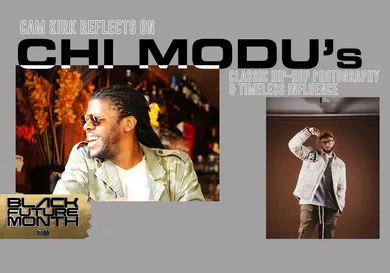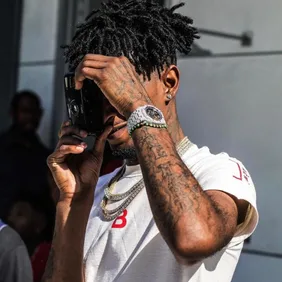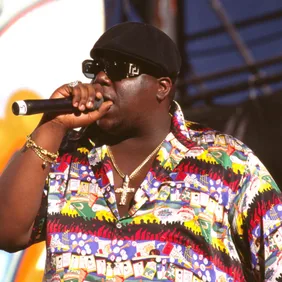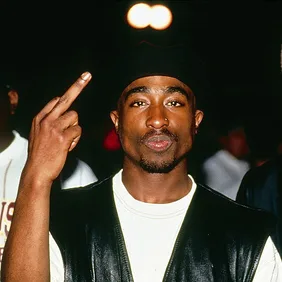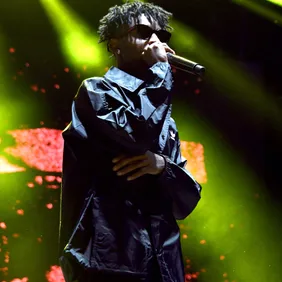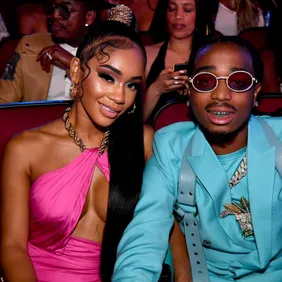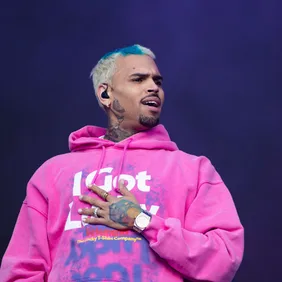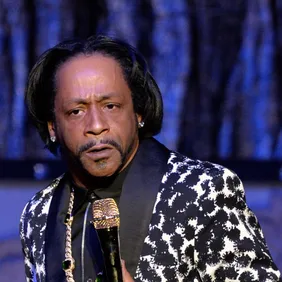Hip-Hop history, like Black history, is riddled with unsung heroes, pioneers, and talented creatives who oftentimes aren’t celebrated until years or decades after their passing. That’s not the case, however, with famed Hip-Hop photographer Chi Modu (pronounced chee mohdoo). Before he unexpectedly succumbed to cancer last May, Modu (1966-2021) was highly regarded for his tenure at The Source and his lifelong career as a photojournalist and documentarian, of Hip-Hop culture and beyond.
Even if this is somehow your first time being introduced to the Nigeria-born and New Jersey-raised photographer, you’ve undoubtedly seen his work. As the visionary behind some of Hip-Hop’s most legendary photographs, Chi Modu’s work spans from iconic portraits of 2Pac sipping on a Heineken, Nas in his childhood bedroom, and Biggie in front of the Twin Towers to distinctive album covers like Mobb Deep's The Infamous, Method Man's Tical, and Snoop Dogg's Neva Left. In 2013, Modu sought to disrupt the exclusive and inaccessible world of art with UNCATEGORIZED, an outdoor art installation that saw some of his rarest and most famous photographs plastered on the sides of buildings throughout New York City. Soon thereafter, UNCATEGORIZED became a worldwide phenomenon, with exhibitions in Finland, Dubai, Nigeria, and Brazil, and even though Chi Modu is no longer here to expand his global efforts, his family has promised that it will “continue the fight” of making art more inclusive.
Chi Modu with Dave East and Nas, 2017 - Johnny Nunez/WireImage/Getty Images
As we celebrate Black History Month — or Black Future Month, according to Kanye West — just eight months after his passing, Chi Modu’s contributions to Hip-Hop are as relevant as ever. Thanks to the illustrious and prolific documentarian, imagery is an undeniably crucial element of Hip-Hop, as illustrated through the work of established and steadily rising photographers like Cam Kirk and Gunner Stahl, who have both continued Chi’s practice of capturing a different side of rappers that fans don’t typically get to see.
Since the past oftentimes informs the future, HNHH recently linked with the aforementioned Cam Kirk to reflect on Chi Modu’s passing, reminisce on his most influential works, and discuss the most significant lessons that he ever learned from the late photographer. Read the full transcript from our exclusive interview with Atlanta-bred, Cam Kirk Studios founder below, lightly edited for length and clarity.
HNHH: The great Chi Modu passed away last spring, and before we dive into his work, let’s talk about how you reacted to his passing. Where were you when you first heard the news and how did it hit you?
Cam Kirk: I’m trying to remember exactly where I was at. Obviously, I heard about it like most people– on social media. I was definitely taken back by it because he’s lived a pretty private life. He kind of only stepped on Instagram to drop a few gems or share some of his past work, so I had no idea that he was dealing with any illness or anything. I took it pretty tough. I won’t say I grew up idolizing him. I wasn’t really aware of his impact, but I was aware of his photos. I didn’t get aware of his impact until I honestly started to pursue photography as a career for myself. Then, he was obviously one of my staples in terms of just Black photographers leading the way, paving the way, creating some of the most iconic photographs in Hip-Hop history. So, I was more so taken back from the legacy of what he did and just the idea of one of our forefathers passing away.
As leaders of your respective generations, did you ever get the opportunity to form a personal connection with him?
I never met him directly or had the privilege to speak on the phone with him, but we actually did connect a few times over social media. I actually was given a gift from a friend of mine for my birthday one year. It was his book, and he signed it and wrote me a letter inside of the book. So, our connection didn’t make it to a personal one, but definitely from a mutual respect. He’s given me words of encouragement along my journey via social. He’s always just been a shining light — someone I can study and understand how to approach what I do. Even in the letter he wrote me, he always speaks on photography as a responsibility. That’s something that I’ve always held close to my heart. It’s like you’re responsible for dictating the imagery of our people. The imagery of our culture. It’s not something we should take lightly, and I couldn't agree with that more.
"Our connection didn’t make it to a personal one, but definitely from a mutual respect. He’s given me words of encouragement along my journey via social. He’s always just been a shining light — someone I can study and understand how to approach what I do."
That’s really inspiring to hear, and that’s beautiful that you have that letter. I know that really means a lot to you even more now that he’s passed. I know you said that you didn’t necessarily grow up seeing his impact, but now that you’ve had some time to look at it in hindsight, how would you describe the impact that he had on Hip-Hop photography?
I mean he freeze-framed a culture. He freeze-framed what Hip-Hop looked like to me. As a child or young adult or teenager growing up, when you look at a photo of Tupac, you just see Tupac. When you look at a photo of Snoop Dogg, you just see Snoop Dogg. It’s not until I developed that passion for photography that I wanted to further see what the connection was. Who is responsible for making Tupac this comfortable? Who is responsible for capturing this iconic image of Snoop Dogg or Biggie at the Twin Towers? Who had that type of foresight? From there, that’s kind of when I was able to see the impact of who he was. Just, how personable he got with his subjects. You could tell him and Pac were friends. At the same time, you can tell him and Biggie were friends, and Snoop obviously had a connection. That was something that for me and carrying the torch — you want to capture authentic moments with these guys. You want your artist to let their guards down when they’re with you. That’s something he did magically without doing too much. I just think that his impact was something that the world needs to talk about more. Hip-Hop people need to talk about more. I hope he feels the flowers, and I hope he’s gotten enough of it to his standards. But, I would like to see a lot more done. For sure.
Chi Modu with his camera at his exhibition in 2012 - Jerritt Clark/WireImage/Getty Images
He did a lot of portrait work, and he had some important album covers under his belt. How did that influence your development as a photographer?
I think I’ve been even inspired by the work he’s done in his last ten years, from his gallery work to his archival of photographs. His photos of Ice T, Ice Cube, and ODB, etc. have remained relevant 20 to 30 years later. I think there’s a lot for photographers to take from that, just understanding the value of your photographs. Not necessarily in a present moment always, but also thinking past the present and the future. I think he set a great example for that, along with a few others. I’ve been really inspired by that and just the way that he captures. I feel like he always took the artists back to their neighborhood and was able to capture their true self. That’s something that I definitely apply to my work. Even photos I’ve taken of Lil Baby, I wanted to capture him in his neighborhood and get his environment and his surroundings. Stuff I’ve done with Gucci. The reason I may want to turn a photo black and white, which was an iconic style of [Modu's]. All of that was just really inspired by his work and his impact.
Let's move on to your favorite images that he shot. If you had to choose three or five favorites, just run me through them one by one.
Wow. That’s hard to choose. I actually just bought nine prints from him for my house. It was hard for me to pick the ones to purchase. I’m just going to put it in categories of the artists he’s photographed. Number one, his collection of work with Tupac is just incredible. Tupac is one of my favorite artists of all time. One of my favorite people of all time. Just to see their connection through photography is incredible, from the moments in his backyard to the iconic ones of Tupac with his shirt off drinking a Heineken. I don’t know, it’s just the way that he captured Pac to me — it’s like none other. It’s just dope. I like to see consistency in people. It’s easy to get in front of an artist one time. But, to be their go-to or somebody that they call on or they lean on when the moment is right is something that is just magical. I think he had that impact with Pac. So I would say, his collection of work with Pac is crazy. Second, I would say his work with Nas. Shooting Nas in his old apartment a little after the Illmatic time, might have been around that time. That photo today is still as iconic as it was before, if not more. Just that photo is so iconic to me because it’s like a young Nas in his roots, in his home, just sitting on the bed. It’s the most simplest thing. It’s the most underproduced photo, but the impact of it is so much greater. I think we have a similar style in that. I’m not like a costume photographer that likes to set props up. I like to use natural, real-world elements and I think that’s what Chi Modu was all about as well. You won’t see a lot of overproduced photos within his collection. It’s kind of like the artist is in their element. Whether it’s in their home or against buildings or street signs, he used real natural elements in his work. That photo of Nas is a living example of that. Number three. Who else has a picture of Biggie in front of the Twin Towers? Just that moment really defines New York City, at least for an outsider. When you think of New York City, you think Biggie of you think of the Twin Towers. Just to have that photo, it’s just crazy. Now, living in a world where those two things don’t even exist anymore makes that photo so much more impactful and groundbreaking. Those are definitely my top three.
Photos Chi Modu shot of Biggie and Tupac on display - Jerritt Clark/WireImage/Getty Images
You hinted at the way he did his exhibitions and shows and how that inspired you. I saw that Fader actually compared your Day 4 exhibit back in 2016 to UNCATEGORIZED as well. How did it feel to be compared to one of the all-time greats in the field?
I was humbled by it to be honest. I hope that he understood my homage that I was trying to do with it. Even in that one, that was actually an idea I had that I wasn’t even, to be as honest as possible, wasn’t even aware that he had did something similar to that until after I was on the path of the Day 4 exhibit. I just did my research further and noticed that nothing is new under the sun. This great brother and great mind was already on that years before me. I didn’t even do anything first. But for my work to have been compared really just brought me even closer. It made me even more of a fan of his impact. Just seeing how his work was even subconsciously inspiring me and so many others to even think like that, it just was amazing. It speaks to his genius and how far ahead of his time he was. A lot of people thought I was ahead of my time for doing that, and little do they know it’s been done before by an even greater man.
Since you grew up seeing these pictures but didn’t necessarily attribute them to Chi, I’m curious to hear what was that “Aha!” moment like when you realized he was the person behind these photos?
I think it was when I first got into photography. One of the first things I did, and I always tell other people, you have to study who came before you to know what’s going on. I grew up a huge collector of The Source magazine. From that point on, I just started to look at old Source magazine covers and thinking, “Who shot this? Who did this? Who’s the one that did this?” Just thinking about photos that move me, and I just kept finding Chi Modu, Chi Modu, Chi Modu, Chi Modu. From there, it just was like wow. There’s really somebody with a catalog like this. Between him and Johnathan Mannion, to me, it doesn’t get much greater in Hip-Hop between those two guys. So, when I was just kind of on my journey of finding the forefathers before I stepped into it, that was the “Aha!” moment for me. And he’s Black!? A Black man was actually doing this at some point at a time? That just kind of moved me because at first, all I was seeing was white guys to be quite honest. They were just shooting us for the magazines, so to know that there was a brother out there doing that, it just moved me and inspired me to be greater.
"I grew up a huge collector of The Source magazine. From that point on, I just started to look at old Source magazine covers and thinking, “Who shot this? Who did this? Who’s the one that did this?” Just thinking about photos that move me, and I just kept finding Chi Modu, Chi Modu, Chi Modu, Chi Modu. From there, it just was like wow. There’s really somebody with a catalog like this."
For sure. I remember last year, I wrote about Ricky Powell's passing, and it's insane to think that these people were able to have such an impact through their photography.
It’s a shame that they aren’t given their flowers while they’re here. These guys should want for nothing, in my opinion. They should be at the top of everyone’s mind when you think of the construction of Hip-Hop and the way we look at Hip-Hop in general. It was told through their eyes and their lens. Hopefully, we attempt to appreciate and honor the photographer as much as the other participant within the culture.
Something you said earlier actually sparked two questions I want to touch on real quick. You were talking about the importance of looking back. Seeing that this is Black History Month and HNHH is kind of adopting Kanye's approach with Black Future Month, I want you to look into the future for a second as well. As Chi offered kind words to you, which rising photographers would you like to offer kind words to as well?
I think that’s a part of my legacy. That’s a part of what I do with my studio at Cam Kirk Studios. We built a community here in Atlanta fostering the next generation and the current generation of photographers. Giving them the tools, resources, motivation, and knowledge that they need to attack the industry and beyond. I tell that same story through my life, through my platform, through what I do in my world. Whether that’s through lectures, artist talks, or my Night School series. Also, I started my label Collective Gallery, which is a label — the first of its kind — that actually signs photographers instead of musicians. It’s all about fostering the next-up and building a community because, at the end of the day, it takes more than just me and Chi and whoever else is doing it. We’ve got to keep this thing going. It takes all of us. It takes the next generation to give more impact to the work that we’re doing today. It takes continuation. For me, that’s like a natural part of what I do. I mentor a lot of photographers. I mentor a lot of creatives in general.
Chi Modu's photographs on display at his 2012 exhibition - Jerritt Clark/WireImage/Getty Images
Got you. Also — when you were answering a previous question, you mentioned the founding fathers, which leads to another question I had for you. If there was a Mount Rushmore of Hip-Hop photographers, who do you think would be there? If you want to include yourself or take yourself off, that's cool. I'm just curious about who you would put on there.
That’s tough. Chi Modu... Alright, my Mount Rushmore would be Chi Modu, Jonathan Mannion, Jack Wilson, Diwong Valdez, and myself.
Respect. Well before we wrap up, what are the lasting lessons — be it a certain approach to photography, ownership, or whatever else — that learn from Chi Modu?
Ownership for sure. Ownership of your work. Ownership of your legacy. Also, planning for the future. His catalog is unmatched because he controls the copyright, the IP of his work. It’s like owning your masters. That’s like one of the biggest lessons I learned from him. You rarely will see Chi’s work used in a commercial space, but he’s able to make a huge impact and the career for himself just living off his legacy and the work he’s created. So, ownership is definitely priority number one.
Bet. I appreciate your time man. As someone out of Atlanta, this means a lot. Hope you enjoy the rest of Black History Month. Salute.
You too man. Thank you so much for your time.
Did our interview with Cam Kirk strengthen your appreciation for Chi Modu's work? Let us know what you think about Modu and his impact on Hip-Hop in the comments below, and stay tuned for more Black Future Month content.
